Appendix 1
A Translation of Eusebius’ Letter to Carpianus
The translation below is based on the Greek text printed in NA28, pages 89*–90*.1
Eusebius, to Carpianus, beloved brother in the Lord. Greetings.
Ammonius the Alexandrian, having naturally put in a lot of hard work and study, has left behind for us the Diatessaron-Gospel, in which he placed alongside the [Gospel] according to Matthew the concordant sections from the other evangelists. The unavoidable result was that the continuous thread of the other three was destroyed, as far as a text for reading is concerned. So in order to preserve the body and sequence of the other [gospels] throughout and yet still be able to know the particular passages in each evangelist where they were moved by love for the truth to speak about the same things, I took my starting points from the labour of the aforementioned man, and, with the application of a different method, I have designed ten canons for you, which are subjoined [to this letter].
The first of these contains the numbers in which the four have spoken about similar matters—Matthew, Mark, Luke, and John;
the second [contains the numbers] in which the three [have spoken about similar matters]—Matthew, Mark, and Luke;
the third [contains the numbers] in which the three [have spoken about similar matters]—Matthew, Luke, and John;
the fourth [contains the numbers] in which the three [have spoken about similar matters]—Matthew, Mark, and John;
the fifth [contains the numbers] in which the two [have spoken about similar matters]—Matthew and Luke;
the sixth [contains the numbers] in which the two [have spoken about similar matters]—Matthew and Mark;
the seventh [contains the numbers] in which the two [have spoken about similar matters]—Matthew and John;
the eighth [contains the numbers] in which the two [have spoken about similar matters]—Luke and Mark;
the ninth [contains the numbers] in which the two [have spoken about similar matters]—Luke and John;
the tenth [contains the numbers] in which each of them has recorded certain matters on his own.
Now this is the subject matter (ὑπόθεσις) of the subjoined canons and here is a straightforward explanation (διήγησις) of them.2 In the margin alongside each of the four gospels a sequence of section numbers is prefixed, beginning with one and carrying on successively through two and three, and so on in series throughout the entirety of the books until the end. And below each number there is a notation in red which indicates in which of the ten canons the present number occurs. So if the notation is a ‘1’ [αʹ], then it is in the first [canon]; if it is a ‘2’ [βʹ], then it is in the second [canon]; and so on for all ten. So if, on opening any of the four gospels you like, you want to study whatever chapter (κεφαλαίῳ) interests you—that is, to know who has said similar things and to find out the respective passages in each [gospel] where they felt moved [to discuss] the same things—then note the number prefixed to the section you’re concentrating on and search for it within the canon suggested by the red notation, and immediately, based on the titles in the heading of the canon, you will know how many and which [of the evangelists] have spoken about the matter that you are looking for. And by studying also the numbers of the other gospels that are lying adjacent in the canon you are holding, and looking for them within the respective passages of each gospel, you will find them saying similar things.
Appendix 2
Eusebian Parallels in Augustine’s De consensu evangelistarum
What follows is not simply a list of the passages discussed by Augustine in De consensu. In other words, it is not a comprehensive biblical reference index. Rather, I have included only those passages that Augustine discusses together as some sort of parallel, along with the explicit comments he makes along the way about passages unique to a given evangelist. Hence, this table is not as comprehensive as it could be, but by following this method only those places where there is the clearest evidence of dependence on Eusebius’ Canons are included.
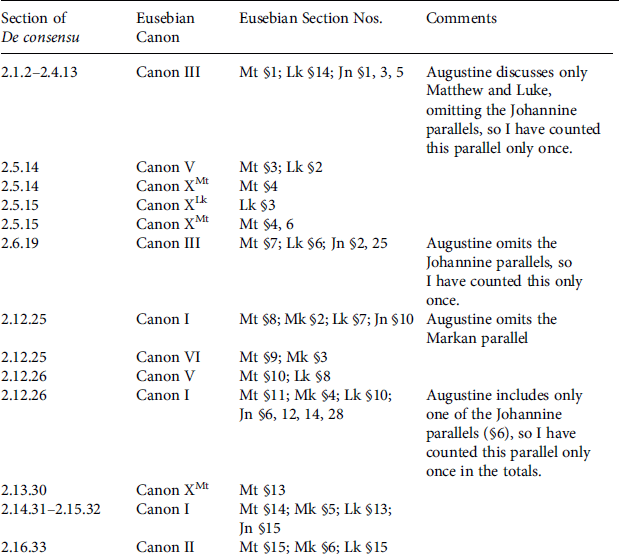
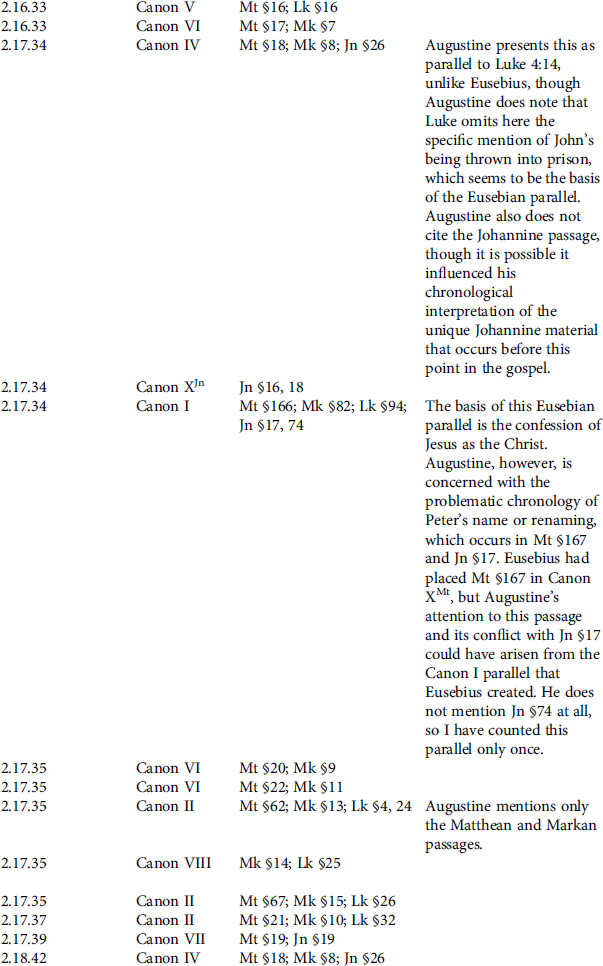
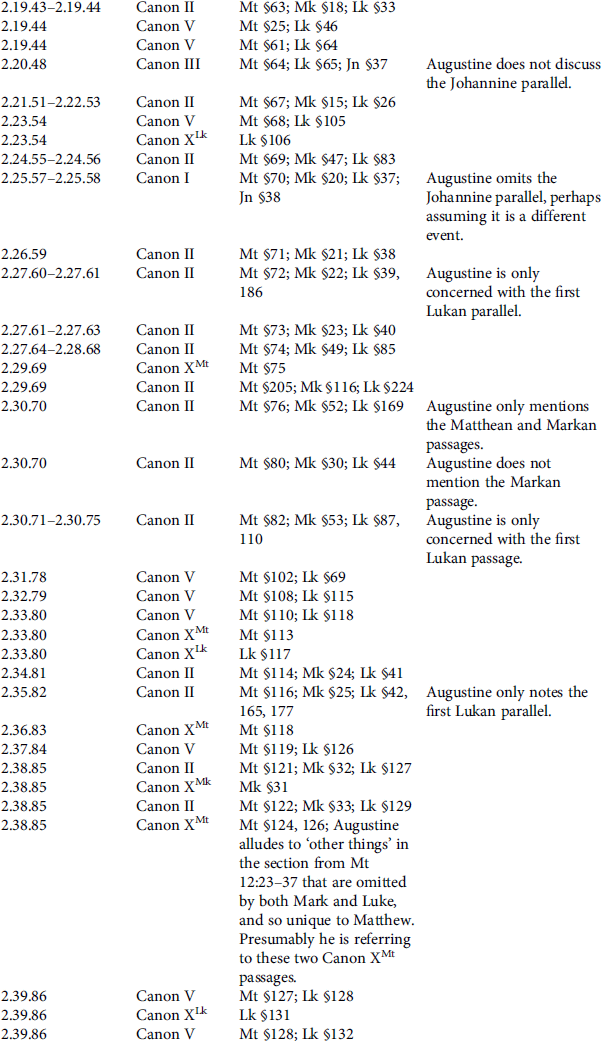
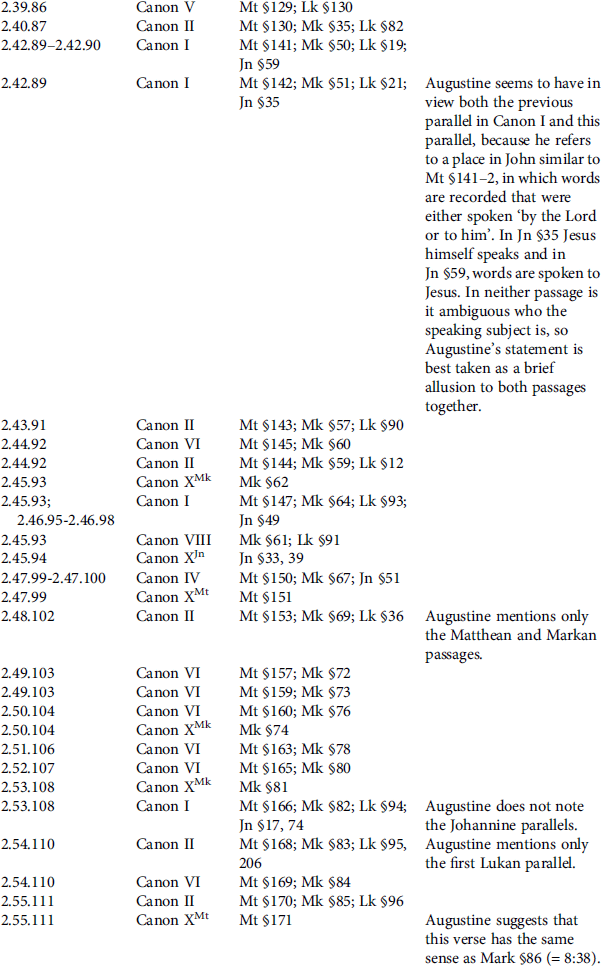
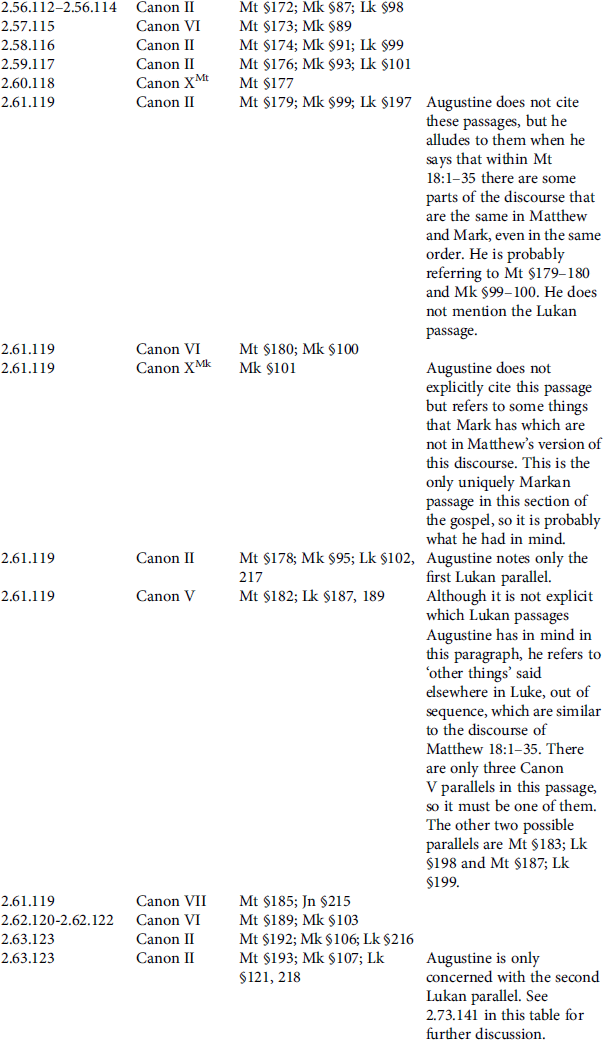
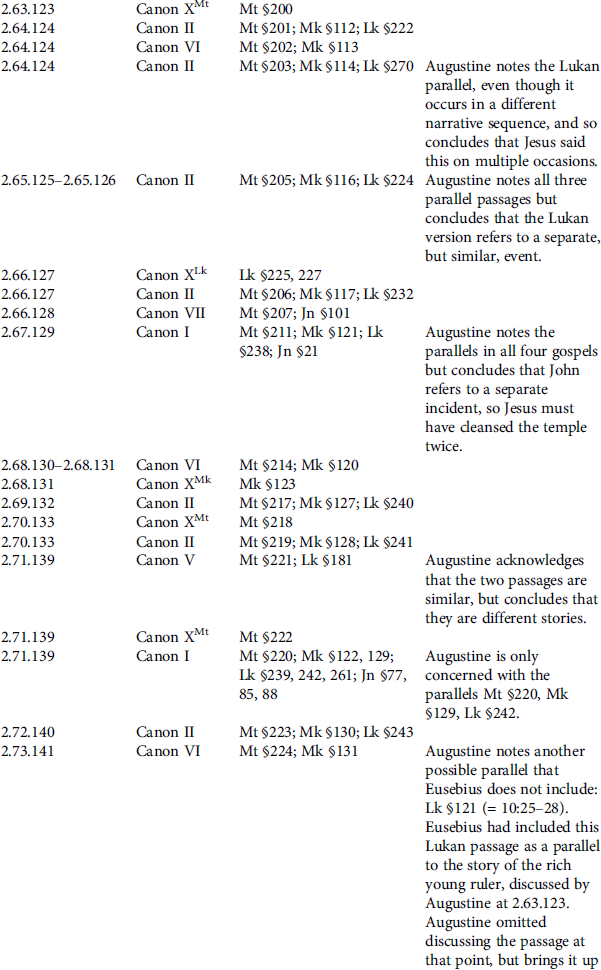
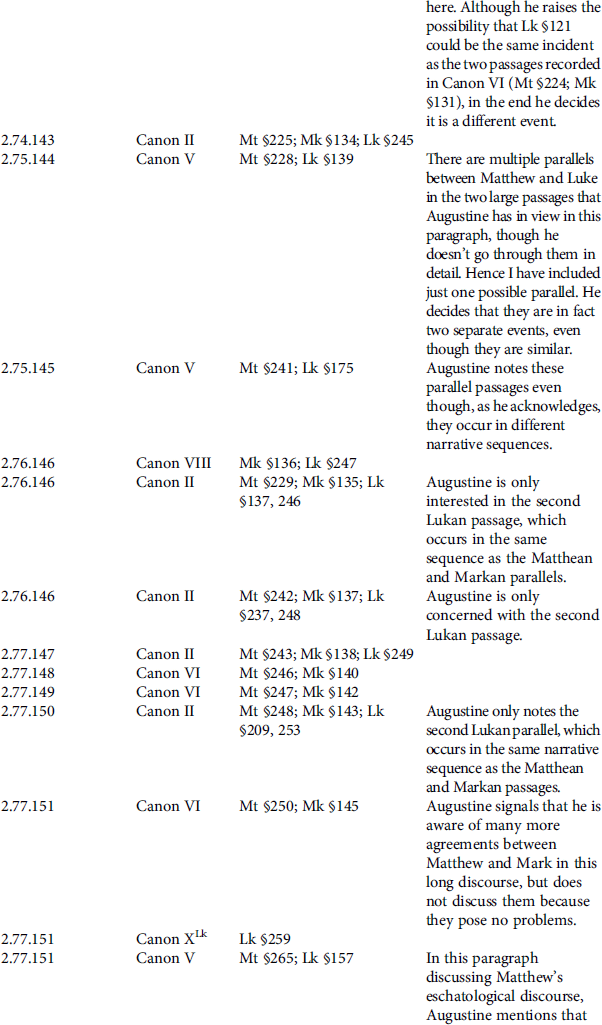
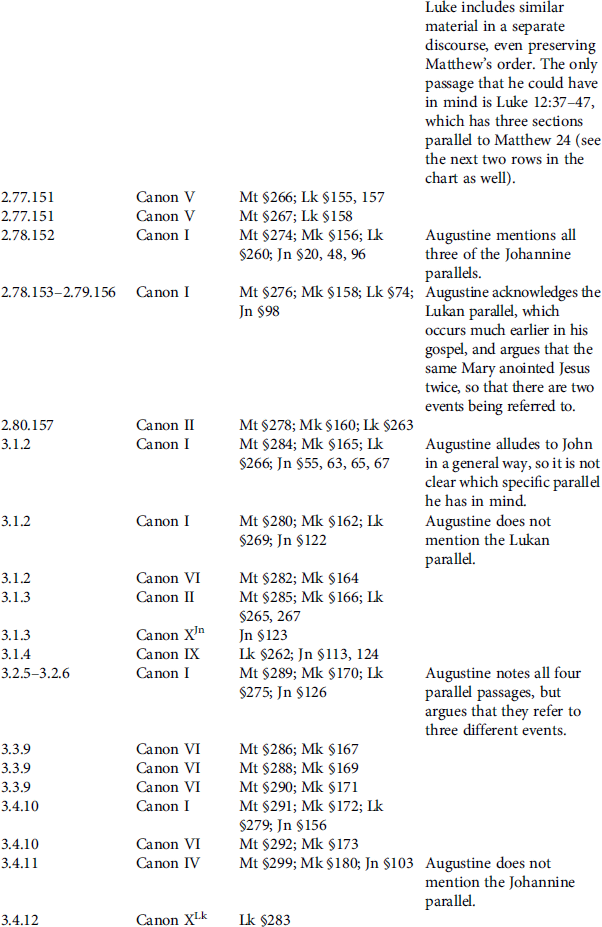
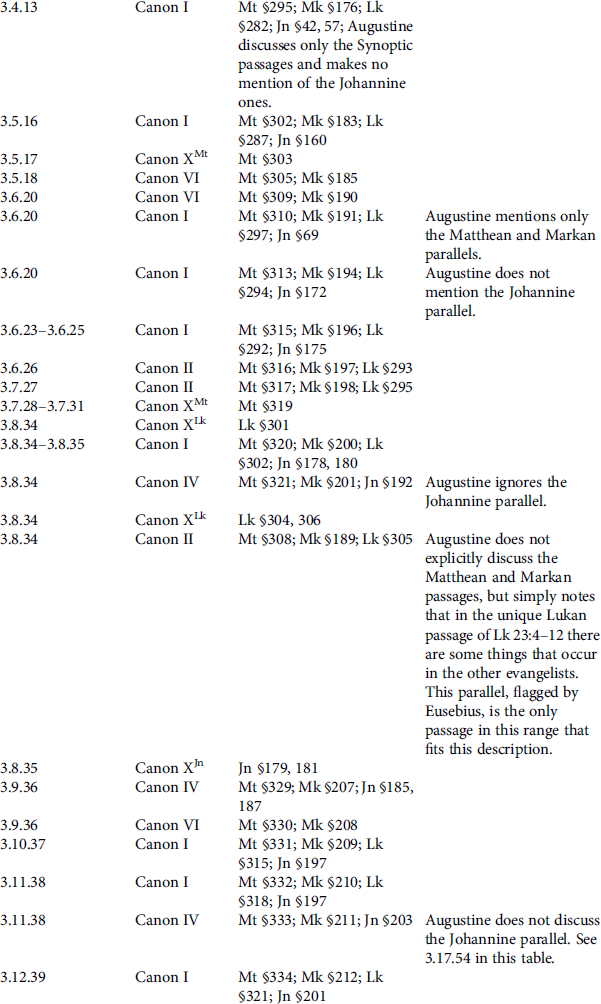
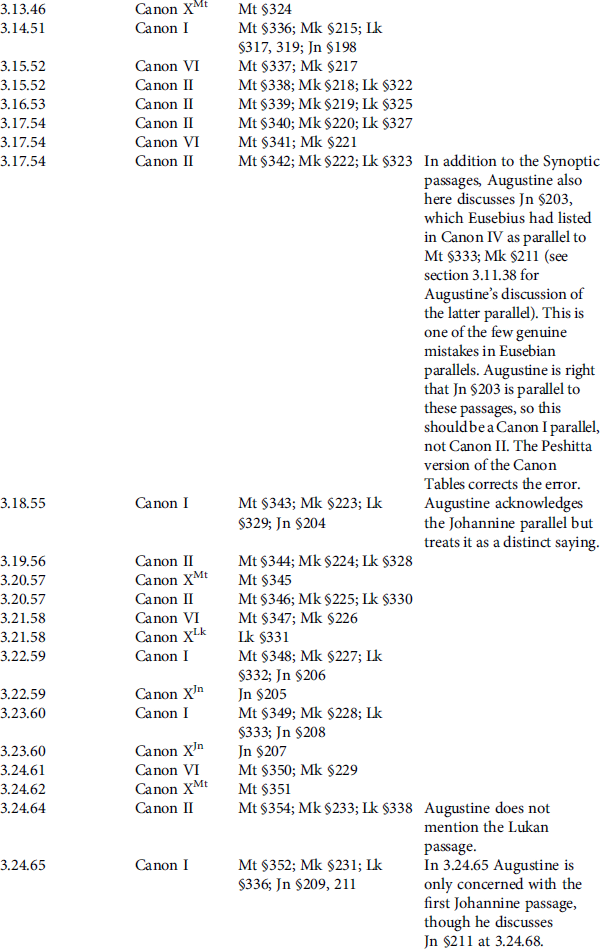
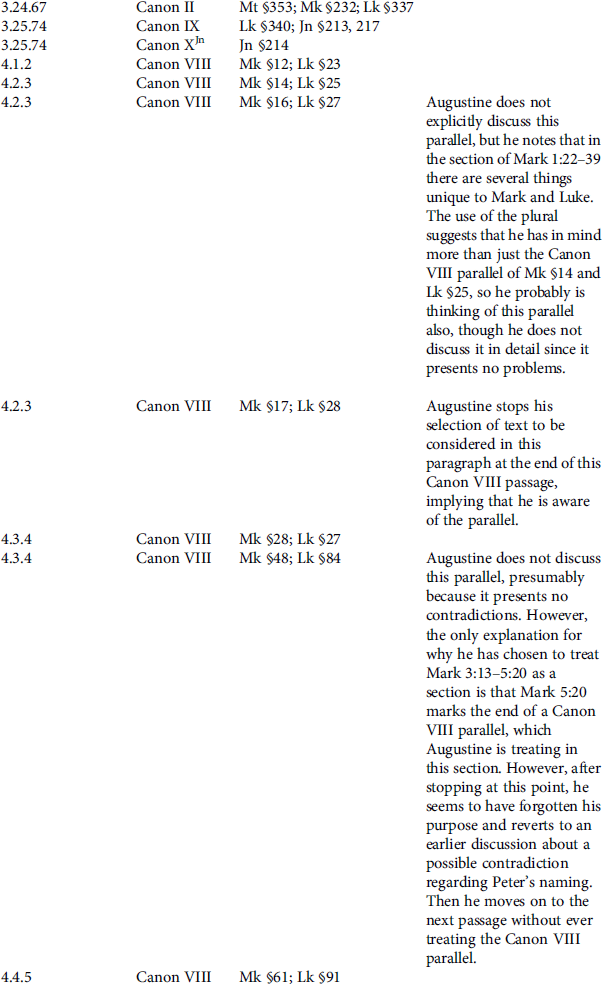
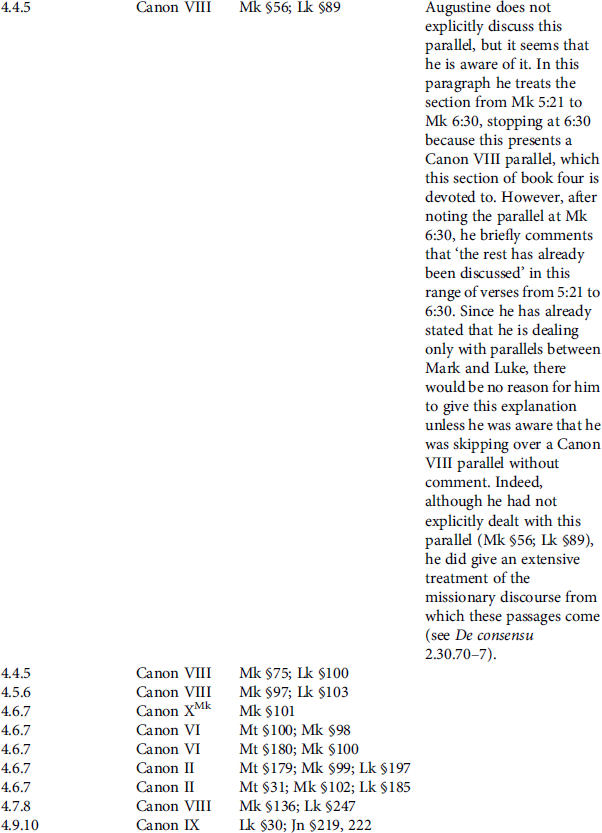
Summary Table
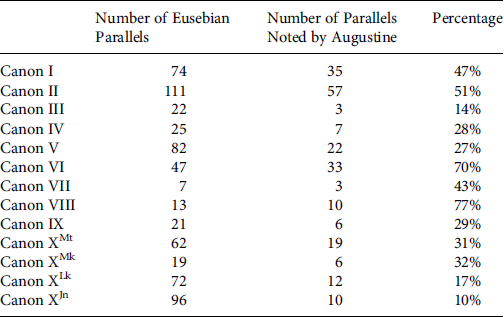
Appendix 3
The Gospel Synopsis in Codex Climaci Rescriptus and its Possible Connection to Ammonius’ Diatessaron-Gospel
In chapter two of this book I suggested that no trace of the gospel synopsis produced by Ammonius of Alexandria has survived to the present day, and in making this claim I was merely following the scholarly consensus on this question. There is, however, a little-known exception to this consensus which warrants discussion here as an appendix to the present volume owing to its possible relation to Eusebius’ Canon Tables. As suggested by its name, the manuscript known as Codex Climaci Rescriptus (CCR) is a palimpsest whose overtext is a Syriac translation of two works by the Byzantine ascetic John Climacus, head of St Catherine’s Monastery at Mt Sinai in the sixth century. The final manuscript that has come down to us is a product of the ninth century, but, in order to create the palimpsest, the ninth-century scribe reused portions of ten previous manuscripts, now known as CCR1-10. The manuscript is well-known in some specialist circles owing to the fact that six of its constituent parts contain the largest surviving corpus of Christian Palestinian Aramaic. However, the second most sizeable portion of the manuscript, now known as CCR5 and running to twenty-four folios,1 has as an undertext portions of the gospels in Greek, which has received very little scholarly attention despite the fact that it must count as one of the most unusual witnesses to the text of the gospels to have come down to us.
A portion of this Greek undertext was published in 1909 by Agnes Smith Lewis, who was involved in the purchase of the manuscript and its relocation to Cambridge.2 In 1956 Ian Moir published a fuller edition, after having applied ultraviolet light to the palimpsest to recover much more of the Greek undertext. Although nothing more has been published on CCR5 since Moir’s edition, a research team in Cambridge will soon be producing a new edition with commentary and analysis based on a re-imaging of the manuscript using the latest technology. The present discussion was undertaken with some awareness of the preliminary findings of this research project, and although the following analysis depends solely on Moir’s study, so far nothing I have seen of the new research would invalidate the conclusions presented here. Of course, further discoveries made possible by new imaging of the manuscript could change the picture considerably.
The reason for the inclusion of a discussion of CCR5 here is that a portion of the text of the Greek gospels in CCR5 presents parallel passages from the gospels collected together in synoptic-like fashion, leading an anonymous reviewer of Lewis’ 1909 publication to comment that ‘it does not at all agree with what we have of Tatian’s harmony (Ciasca, Fuldensis, etc.), and the question arises whether it represents that hardly less famous ancient harmony made by Ammonius in the third century, on the basis of Matthew’.3 Moir was cautious in his judgements, admitting his puzzlement over several features of this manuscript. He did, however, point out that the text in CCR5 could not be a ‘gospel harmony’ but might represent ‘the rough drafts of some worker who planned to produce an early equivalent of Tischendorf’s or Huck’s synopses. That such works were common we know from the examples of Ammonius and Eusebius’.4 The possible relation of this work to either Ammonius’ Diatessaron-Gospel or Eusebius’ Canon Tables is a question that the Cambridge team is currently investigating. The goal of this appendix is to highlight some of the issues that must be taken into account in forming any such hypothesis.
The undertext contained in CCR5, which Moir dated to 650–700 ce,5 falls into three discontinuous sections: Matthew 2:12–13:46, John 6:53–21:2, and Matthew 26:75–27:40 with parallels. The manuscript presents multiple unsolved riddles (e.g., the passages that for no apparent reason are missing from otherwise sequential sections of narrative text) and here I will focus only on the two features pertinent to the present monograph. First, all three sections of text are demarcated with an enumeration system that is completely unique, without parallel in any other surviving manuscript.6 Like the Eusebian apparatus, the system in CCR5 numbers each gospel separately, starting with 1 at the beginning of each narrative and continuing sequentially to the end of each text. The most striking feature of this enumeration is the fine degree of granularity that it exhibits. The numbered sections vary in length but on average are shorter than Eusebian sections, with the result that the total number of sections in each gospel is greater even than the revised Canon Tables version found in Peshitta gospelbooks. For Matthew, the earliest number recorded is §11, corresponding to a section consisting of Matthew 2:13, and the highest number recorded is §568, corresponding to a section beginning at Matthew 27:37.7 As discussed in previous chapters, Eusebius’ Greek enumeration system for the gospel of Matthew ran to §355 and the revised Peshitta version went as far as §426, so without even reaching the end of Matthew the system in CCR5 has already far surpassed the totals in the two versions of Eusebius’ apparatus. Similarly, the earliest portion of John included in CCR5 is numbered §163 (= John 6:63) and the last portion of text is §490 (= John 21:1), well surpassing the totals in the two versions of the Canon Tables (§232 and §271). The highest number for Mark in CCR5 is §396 (= Mk 15:26) and for Luke it is §560 (= Lk 23:38), again well above the total Eusebian figures for those gospels (§233 and §342 respectively).
This increase in the number of sections in each gospel is explained by the different rationale for the partitioning in comparison with Eusebius’ system. Whereas Eusebius started a new numbered section whenever the text changed its relation to one or more of the other gospels, the method of the system in CCR5 seems to have been to divide the text for almost any reason conceivable, including change of speaker (Mt §127–9 = Mt 9:27–8a, 28b, 28c [Moir, p. 50]), change of subject of the main verb (Mk §383–5 = Mk 15:10, 11, 12 [Moir, pp. 71–2]), citation of Old Testament material (Mt §12 = Mt 2:17–18 [Moir, p. 29]), as well as intuitive narrative breaks like the start of a new parable (Mt §214–16 = Mt 13:36–43, 44, 45 [Moir, pp. 35–6]). As one would expect, some of these breaks coincide with the section breaks created by Eusebius (and perhaps by implication those breaks previously made by Ammonius), but others cut across the Eusebian sections. Some overlap in the two systems of demarcation would be expected simply based on chance, so the convergences that occasionally appear in the start and end of sections cannot be taken as evidence of a link to either Ammonius or Eusebius. It is not impossible that the creator of this enumeration system was aware of Eusebius’ Canon Tables (indeed, it would be surprising if a scribe of the seventh or eighth century was not), but it does not in any necessary way depend upon Eusebius’ prior creation and the differing rationales for the two systems of demarcation point in the opposite direction.
The only admittedly speculative thing that could be said is that a system such as this could have served as a precursor to a cross-referencing tool like the Canon Tables. If one had Eusebius’ goal of finding all gospel parallels and had nothing more than a completely undifferentiated text to work with, one possible initial step would be to divide the text in every conceivable place and then recombine the sections as necessary as one identified the parallels that exist across other gospels. This hypothesis is impossible to confirm and surely other explanations for the paratextual features of this manuscript could be offered. Whatever the case, the numbered demarcation system in CCR5 is remarkable for its idiosyncrasy and raises the question of what other numbering systems might once have existed but have since perished. Hence, while it cannot be excluded that this is a lone preserved fragment of Ammonius’ Diatessaron-Gospel, neither is there evidence to suggest that it is. Nevertheless, even if there is no direct connection to Ammonius or Eusebius, the fact that a seventh- or eighth-century scribe copied the work testifies to a broader interest in the issues of demarcation and paratextuality in the Byzantine period.
The second relevant feature of CCR5 is just as striking. As noted above, the third section of text comprises Matthew 26:75–27:40 with parallels. It is the latter that once again is utterly idiosyncratic in comparison with the rest of the manuscript tradition of the Greek gospels. The text of CCR5 is written in two columns throughout, as is typical for Greek gospel manuscripts. However, for this section of text from the Passion narrative of Matthew the columns do not simply present a continuous running text of the first gospel, but instead intersperse Matthew’s text with the parallels from one or more of the other three gospels, producing something akin to a modern gospel synopsis. The most significant difference between a modern synopsis and the mis-en-page of this section of text in CCR5 is that the parallels in CCR5 are read down a single column rather than across the columns. So, for example, on fol. 95r (Moir, p. 69) one first reads Matthew 27:35–6, and immediately below the text of Matthew one finds Mark 15:24, followed by Luke 23:34 and next John 19:23–24a, which carries over into the first six lines at the top of the next column. Immediately following the Johannine passage the scribe picks back up with where he left off the text of the first gospel, copying Matthew 27:37, once again followed by parallels underneath.
The features that caused Lewis’ anonymous 1910 reviewer to propose that this manuscript might be a fragment of Ammonius’ work are obvious. No other Greek gospel manuscript to have survived gathers parallel gospel passages in this manner, and Ammonius is the only person from antiquity who we know engaged in this kind of work. Moreover, the presentation of parallels in CCR5 gives priority to Matthew, as also did Ammonius, according to Eusebius’ report in the Letter to Carpianus. Furthermore, there is significant overlap in the parallels presented, bearing in mind, however, that this is only a short fragment of text. To take the example just mentioned, here is Matthew 27:35–6 and parallels in CCR5 in comparison with those of Eusebius:

As one can see, the parallels mostly correspond but disagree on where to conclude the sections from the final two gospels.
From what I can tell, once again it is possible, but impossible to confirm, that this juxtaposition of parallels could be somehow related to the works of Ammonius and Eusebius. A thorough analysis of the new images of the manuscript might help to confirm or disprove any such connection, particularly if other marginal paratextual features are revealed. Whatever new discoveries come to light, there are, in my view, three issues that need to be considered. First, it is just as likely (in fact a priori more likely) that this is a system of parallels inspired by Eusebius’ creation as (than) it is that this is the work of Ammonius upon which Eusebius drew to create his paratextual apparatus. Secondly, the relation of this synopsis material to the wholly idiosyncratic enumeration scheme used throughout CCR5 is not readily apparent. As noted above, the enumeration of the text is not designed to facilitate the presentation of cross-references and at best could be considered a step along the way towards the kind of numbering system Eusebius produced. It seems unlikely that these two unique features of CCR5 should be unrelated to each other, but it is not clear that they are serving the same purpose, particularly given that the whole of the text is enumerated while only a portion of it is presented in a synopsis format. Finally, it may be significant that it is only the Passion narrative that is presented in synopsis form. The Harklean translation of the Syriac gospels includes, following the usual text of the four gospels, something usually called a Passion harmony, which consists of a combined version of the Passion narratives drawn from all four gospels. The purpose for this Passion harmony is not stated but it would have an obvious liturgical utility, so it may be that it was created to be used for the gospel readings during Holy Week. At the very least, it demonstrates that in the early seventh century when the Harklean was translated from the Greek, some had a particular interest in harmonizing the Passion accounts, and this might be related to the Passion text presented in synopsis form in CCR5. In other words, we should not assume that simply because the Passion account of CCR5 is presented in this form it must derive from a synopsis of the entirety of the fourfold gospel or was intended to lead to such. It could simply be another instance of scribal experimentation with this most important of passages from the gospels, perhaps with some liturgical use in view.
Appendix 4
Theophanes the Grammarian’s Note about Canon Tables
In his influential discussion of the Canon Tables apparatus, Hermann von Soden pointed out that in twenty-five per cent of the codices he examined he discovered numbers in the Canon Tables that diverged from the original figures Eusebius had designed. This lamentable state of affairs he found confirmed by a much earlier scholar who had undertaken a similar investigation and who left behind a ‘short essay’ (‘kleinen Aufsatz’) about his own efforts at investigating the textual transmission of the Eusebian apparatus and correcting the mistakes that had crept into the tradition.1 The relevant note occurs on fol.7v–8v in a fourteenth-century gospelbook held by the National Library of Greece (no.92; GA number 1410),2 and is attributed to an otherwise unknown ‘Theophanes the grammarian’. In 1984 Carl Nordenfalk again drew attention to this Theophanes and questioned whether his efforts at restoring the Eusebian original might have left traces in the manuscript tradition.3 Answering this question is beyond the scope of the present monograph but would naturally be taken into consideration in the preparation of a critical edition of the Eusebian tables. However, it does seem appropriate to include a translation of the relevant text, given the relative difficulty of tracking down Theophanes’ note and what it reveals about the reception history of the apparatus, namely that all of the copies of the Canon Tables he could find were so divergent from one another that he had to recreate the ten prefatory tables on the basis of closely studying the section division and enumeration within each gospel.4
A further division (ἐπιδιαίρεσις), exact and without error, of the numbers contained in the ten Canons of the four holy gospels, which was made by Theophanes the Grammarian of Kratrianos.
Eusebius, named for piety, taking his starting point5 from the outline (ὑποτύπωσις) produced by the labour6 of Ammonius of Alexandria, with skill and accuracy marked out7 the ten Canons of the four holy gospels, as he himself testifies in writing to Carpianus. By the numbers enclosed within each Canon, he clearly showed how many of the holy theologians and evangelists have said similar things8 on a given subject, as well as the location of these passages and their wording. And it was such a clear work, and so well divided, and most carefully arranged. But many of those who copy the divine book of the holy gospels, being overcome by inattention and considering it in a superficial and haphazard way, extended the numbers in the ten Canons without end and mixed them up: they inserted additions and multiplications into it in some places and omissions in others, and even substituted in different [numbers] with great licence. So I conducted a more diligent reading and painstaking investigation, and, after gathering together many of the copies, I found that they didn’t match at all and were all corrupted9 by scribal error and in a state of disorder. I therefore realized that I had to attend to the text10 of the four holy gospels and to select from there the section numbers contained in each of the evangelists, and thus to learn the truth. Once this had been completed and the truth had been brought to light with certainty, in the present outline only those section numbers were included which Eusebius, who originally composed the Canons with skill and rigour, also marked down11 in his; that is, for the first Canon all the [sections], along with their type and contents, that were inscribed in St Matthew and St Mark and St Luke and St John too. And proceeding on for the other Canons also, the same division and outline (ὑποτύπωσις) were made accurately and with love of the truth,12 with every addition and omission driven out. Therefore, let anyone who studiously13 reads the present outline (ὑποτύπωσις) of the Canons clearly know that nothing extra or missing will be found in them, but that those who also want to include an outline of the Canons in any of the copied books will gain certainty and surety from this one.